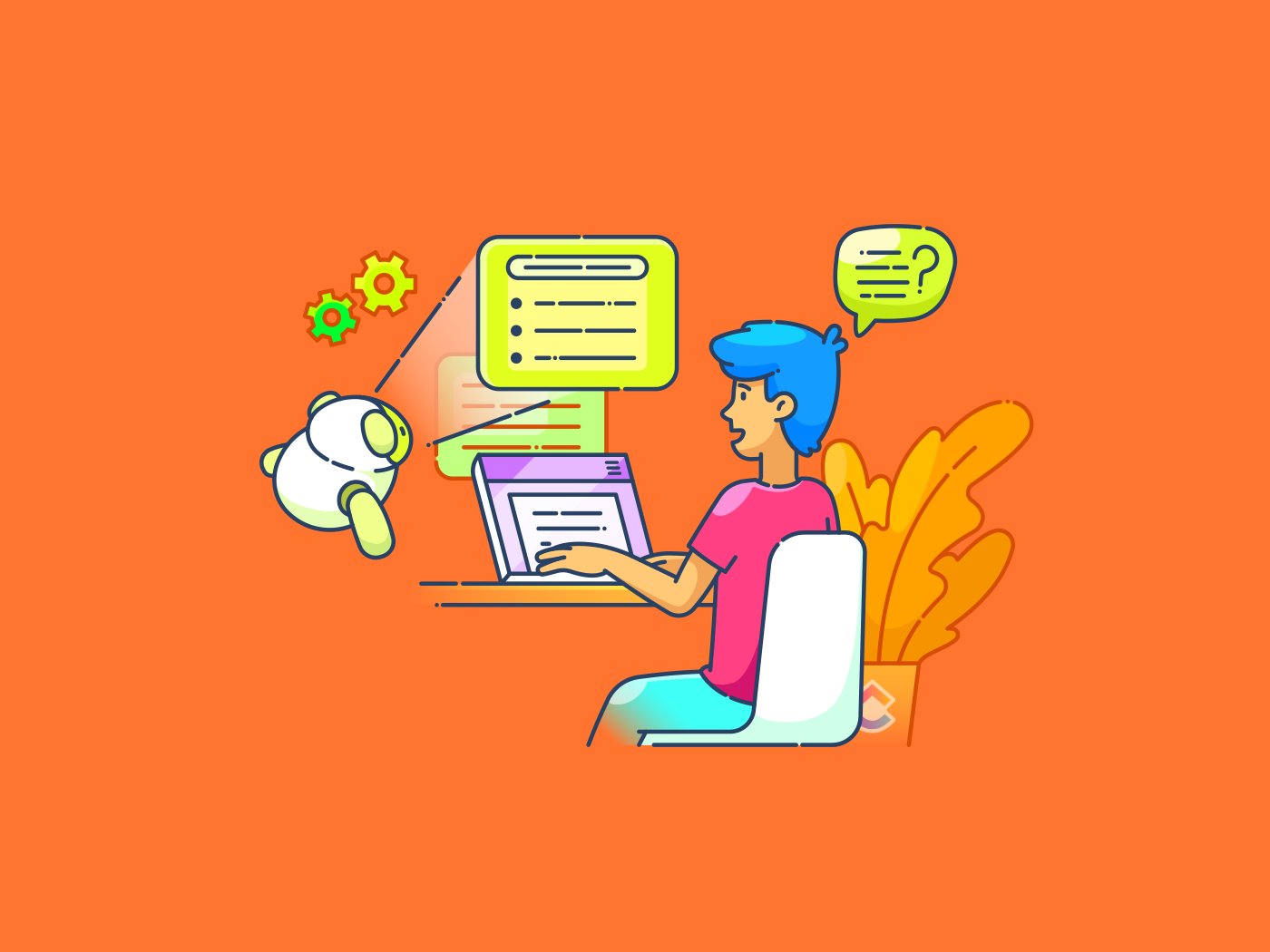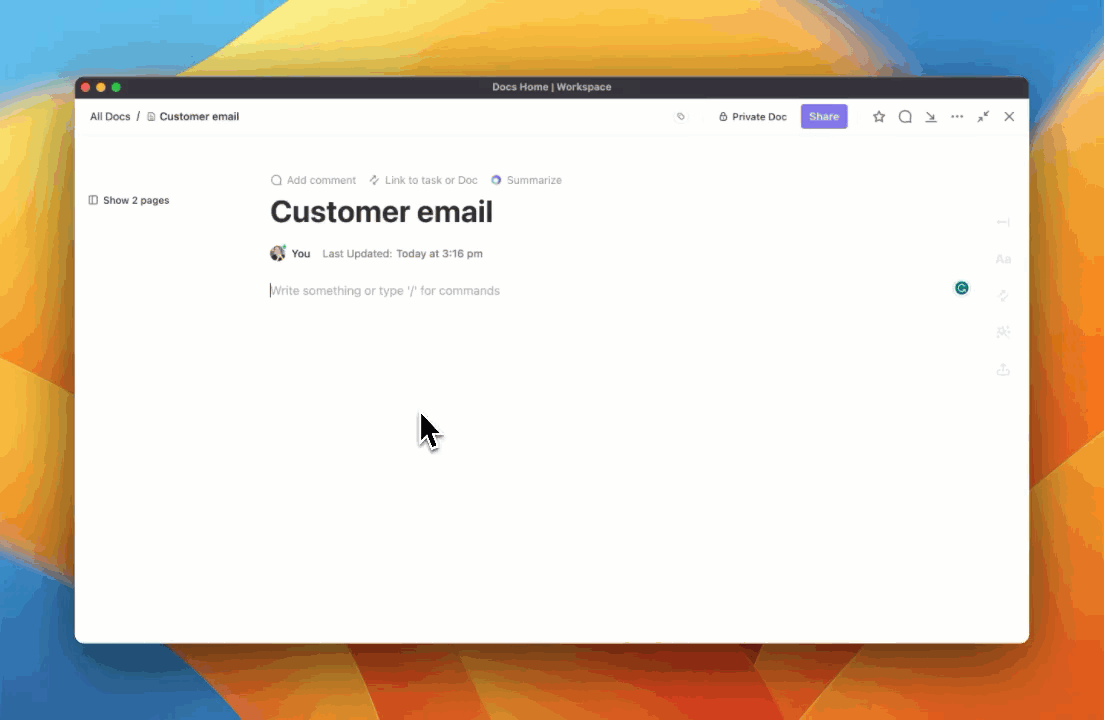How to Use ChatGPT for Customer Service

Sorry, there were no results found for “”
Sorry, there were no results found for “”
Sorry, there were no results found for “”
Customer service teams are bogged down by repetitive tasks, high ticket volumes, and outdated systems, while customers grow increasingly frustrated with long wait times and lackluster responses.
Although many efforts have been made to use chatbots for better customer service, the results have been largely unsatisfactory. ChatGPT—built on large language models (LLMs)—changes the game.
It can potentially increase your issue resolution rate by 14% and reduce the time spent handling an issue by 9%. How about that!
Implementing ChatGPT for customer service is a solid bet that can deliver better customer retention and satisfaction. It’s the first time we’ve looked at something that looks like human intelligence and could solve the last-mile problem of communication.
If you’re considering implementing ChatGPT for customer support but are still unsure, this is the guide for you.
If you’ve ever been stuck on hold, waiting endlessly for an agent, you know how frustrating customer service can be. Think of ChatGPT as a virtual assistant that listens and responds like a human.
What makes it stand out? Its ability to handle conversations and user interactions naturally. Instead of sticking to pre-written scripts, it recognizes context, responds thoughtfully, and answers questions without human intervention. Primarily, ChatGPT helps customer service teams:
How often have you had to explain a simple issue to a chatbot that just doesn’t understand?
Now imagine a customer dealing with a broken laptop charger. Instead of recognizing the problem, a standard chatbot might demand specific keywords like “return” or “support,” ignoring the customer’s frustration.
Here’s where ChatGPT stands out. A GPT-powered AI chatbot can understand the context and intent behind each query. This is a huge advantage over traditional chatbots, which are programmed to respond with templated answers.
Its deep learning algorithms understand customer service etiquette, allowing it to respond with empathy, ask meaningful questions, and provide clear solutions. This makes customers feel heard and reduces the back-and-forth that causes frustration.
💡Pro Tip: Train ChatGPT with past chat logs and knowledge base to generate more accurate and nuanced responses suited to your industry.
ChatGPT excels at handling routine questions, making it a perfect tool for automating FAQs.
Imagine a customer asking, “What’s your return policy?” Instead of waiting for an agent, ChatGPT can instantly provide a clear response or even direct the customer to the relevant page.
By automating these routine queries, your support team can focus on solving more complicated issues.
⚠️ Did You Know? An HBR study reveals that 81% of customers prefer solving their problems independently before calling a live agent.
If you’re unsure about ChatGPT handling customers directly, let your support agents use it to speed up their work.
By leveraging ChatGPT, agents can generate detailed, professional responses to common inquiries in seconds, saving them the hassle of starting from scratch.
Let’s say a customer asks how to troubleshoot a device. Instead of writing the entire response from scratch, support staff can use ChatGPT to create a quick, actionable guide.
Whether it’s to restart the device or check specific system settings, ChatGPT will offer clear steps. The agent can then tweak the answer with a bit of personal touch and send it off without risking sounding like a robot.
💡 Pro Tip: Use ChatGPT to draft customer journey templates for recurring inquiries and customize the responses. Now, use these templates every time the same inquiry pops up.
ChatGPT ‘speaks’ and understands multiple languages. You can use it to connect with customers worldwide without needing a team of multilingual agents. This makes it a practical way to support a global audience and expand your reach economically.
For instance, if a customer from Spain asks, “¿Cómo cambio mi contraseña?” (How do I change my password?), a customer service representative won’t have to scratch their heads trying to figure out the basic meaning.
They can use ChatGPT to understand the question, form a step-by-step guide in Spanish, and resolve the query. No longer waiting for language experts to solve what could potentially be a generic query.
Besides, this quick and customized approach will add a personal touch to the overall customer experience.
🧠 Fun fact: Duolingo, the prominent language learning platform, uses ChatGPT to answer common questions about its language services in over 30 languages!
Whether it’s Christmas, a public holiday, or unusual queries at 3 am—your business can manage customer inquiries promptly without creating a deadly backlog.
Let’s say a customer in a different time zone needs help with their order at 2 a.m. Generative AI tools will answer customer queries without manual intervention. By the time your human agents log back in, they’re ready to focus on more complex, live interactions, leaving the routine stuff to ChatGPT.
➡️ Read More: Customer Management Strategies for CRM Teams
ChatGPT can be used to scan and gather key details from customer inquiries and route the conversations to the best-suited agent. It can organize and prioritize incoming queries based on issue type, customer info, or urgency.
Say you have a technical issue on your hands. ChatGPT can flag it and send it straight to the tech expert. Similarly, if there’s some logistic query, ChatGPT will route them to the appropriate team member, saving your agents’ time and energy.
You can also use artificial intelligence to spot trends, patterns, and emotions. When the query is beyond the AI chatbot’s capabilities, the human agents can take over and address those queries before they escalate.
Growing a small business often comes with the challenge of managing costs, especially when it comes to hiring more staff.
ChatGPT, however, can help you scale your customer service without breaking the bank.
While there’s some setup and training involved, using ChatGPT is usually far more cost-effective than expanding your team. In fact, McKinsey’s The Economic Potential of Generative AI points to 63 generative AI use cases across 16 business functions, including customer operations, with the potential to deliver $2.6 trillion to $4.4 trillion in annual economic value.
💡Pro Tip: Set KPIs to measure customer experience so that you can check the efficacy of AI tools and your support team in generating customer satisfaction.
Training new customer support agents can be tough, especially if they’re new to the industry or your product. ChatGPT offers an effective way to simplify this onboarding process.
New agents can ask ChatGPT about your product, company policies, or customer service protocols and get quick, accurate responses. No need to dig through long internal documents.
Plus, you can even set up roleplay scenarios where ChatGPT acts as a customer, so your agents can practice handling different situations before talking to a real one. Such interactive training is much more engaging (and effective) than simply reading through manuals or watching training videos.
Handling customer feedback can feel like a never-ending task, especially when you have a high volume of messages flooding in.
But instead of having agents sort through hundreds of messages, you can use ChatGPT to automatically analyze customer feedback from different channels. This way, you will save time and focus your energies on taking important actions.
Let’s say you’re a telecom company receiving 500 customer emails a day. Analyzing that massive amount of feedback would take your service team weeks.
You can set up ChatGPT to spot recurring themes, like service quality issues, network problems, or billing complaints. It instantly categorizes the feedback and provides you with key insights—without the manual work.
This way, instead of taking hours to analyze data, you get to spend your time acting on the insights ChatGPT provides, making data-driven decisions that lead to better customer experiences.
Writing customer emails that actually catch attention and drive action can be a challenge for support agents—especially when it comes to offering promotions and deals.
With ChatGPT, your support team can generate relevant email drafts in seconds. They can then fine-tune those emails and add a personal touch, which would still take relatively much less time than generating emails from scratch.
Let’s say the customer’s subscription plan ends in 5 days. With AI, your agents can draft persuasive yet non-pushy emails that can encourage customers to upgrade their services.
➡️ Read More: Best AI Email Marketing Tools
Like with most technologies, ChatGPT for customer service has drawbacks, the most significant being its generic and unpredictable response to user interactions. The other limitations are:
ChatGPT cannot handle nuanced scenarios that other customer service tools already manage. For instance, it can’t set up workflows, offer omnichannel support, or manage catalogs for agents.
You’ve seen how ChatGPT can improve your customer service. While it’s an excellent alternative to standard chatbots, it has multiple issues that will impact your long-term workflow.
Integrating ChatGPT with your existing systems—CRM components and databases—is a major hassle due to compatibility issues. In addition, it’s unable to handle customer service workflows and streamline task management.
But what if there’s an AI-powered tool to supercharge your customer service process and maximize your team’s productivity?
Enter ClickUp—the everything app for work! It’s your answer to efficient and streamlined customer service operations powered by AI.

Suitable for businesses of any size in any industry, ClickUp for Customer Service is designed to help your customer service agents become more productive in their jobs.

Use it to break support tickets into detailed tasks and subtasks, assign multiple people to handle various aspects of complex troubleshooting, and leave comments to discuss tickets and issues with your team.
For better organization, you can also set task priority levels and have agents flag and tag recurring issues to track customer feedback.

To make things easier, use ClickUp’s built-in AI, ClickUp Brain. This AI-powered assistant handles repetitive tasks, like generating customer notes, email replies, and status updates, helping your team keep customers engaged without extra effort.
Best part? ClickUp Brain has access to information across your workspace and can pull relevant solutions and workarounds within seconds, helping agents get to the resources faster.
To take it a step further, it comes with an AI writer that helps agents draft and refine messages, speeding up the response time further and making ClickUp a comprehensive AI tool for customer service.
Plus, you can use ClickUp Forms to capture customer inquiries and feedback directly. These forms convert customer responses into corresponding tasks, which are automatically assigned to the appropriate team members.

Furthermore, ClickUp CRM centralizes all customer interactions, including support tickets, queries, and account details. This makes it easier for agents to access and manage customer information in one place.
Support shift managers can choose from different customizable views, such as Lists, Boards, and Tables. This helps them monitor and prioritize customer requests based on urgency, agent performance, and key customer experience metrics like response times and satisfaction scores.
For small and growing businesses, you don’t need to build a customer service process from scratch. Instead, you can use one of ClickUp’s 1,000+ customizable templates to help you get started.
If you ask us, we’d recommend ClickUp’s Customer Service Management Template for a kickstart:
Here’s how it helps:
Want to know how this template helps streamline your customer service processes?
There’s more to ClickUp than customer service templates.
For example, ClickUp’s Customer Problem Statement Template helps customer service leaders organize and address customer concerns systematically and create their respective solutions.
Here’s how it helps:
While AI chatbots like ChatGPT won’t replace customer service agents anytime soon, they can significantly speed up workflows and improve efficiency.
ClickUp consolidates customer queries, complaints, and reviews in one place.
Beyond customer support, ClickUp helps you streamline other business processes like task management and project organization with its built-in AI capabilities, making it a versatile tool for varied business needs.
Sign up on ClickUp for free to level up your customer service experience.
© 2025 ClickUp